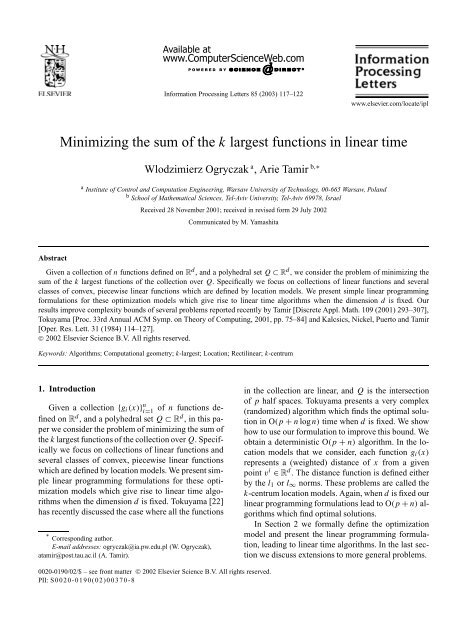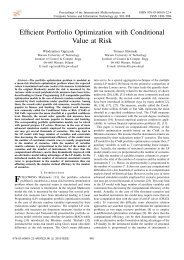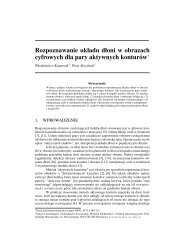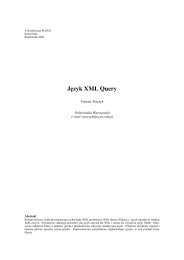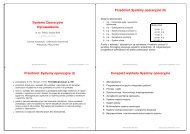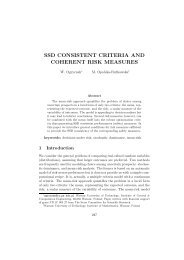Minimizing the sum of the k largest functions in linear time - CiteSeerX
Minimizing the sum of the k largest functions in linear time - CiteSeerX
Minimizing the sum of the k largest functions in linear time - CiteSeerX
Create successful ePaper yourself
Turn your PDF publications into a flip-book with our unique Google optimized e-Paper software.
Information Process<strong>in</strong>g Letters 85 (2003) 117–122www.elsevier.com/locate/ipl<strong>M<strong>in</strong>imiz<strong>in</strong>g</strong> <strong>the</strong> <strong>sum</strong> <strong>of</strong> <strong>the</strong> k <strong>largest</strong> <strong>functions</strong> <strong>in</strong> l<strong>in</strong>ear <strong>time</strong>Wlodzimierz Ogryczak a ,ArieTamir b,∗a Institute <strong>of</strong> Control and Computation Eng<strong>in</strong>eer<strong>in</strong>g, Warsaw University <strong>of</strong> Technology, 00-665 Warsaw, Polandb School <strong>of</strong> Ma<strong>the</strong>matical Sciences, Tel-Aviv University, Tel-Aviv 69978, IsraelReceived 28 November 2001; received <strong>in</strong> revised form 29 July 2002Communicated by M. YamashitaAbstractGiven a collection <strong>of</strong> n <strong>functions</strong> def<strong>in</strong>ed on R d , and a polyhedral set Q ⊂ R d , we consider <strong>the</strong> problem <strong>of</strong> m<strong>in</strong>imiz<strong>in</strong>g <strong>the</strong><strong>sum</strong> <strong>of</strong> <strong>the</strong> k <strong>largest</strong> <strong>functions</strong> <strong>of</strong> <strong>the</strong> collection over Q. Specifically we focus on collections <strong>of</strong> l<strong>in</strong>ear <strong>functions</strong> and severalclasses <strong>of</strong> convex, piecewise l<strong>in</strong>ear <strong>functions</strong> which are def<strong>in</strong>ed by location models. We present simple l<strong>in</strong>ear programm<strong>in</strong>gformulations for <strong>the</strong>se optimization models which give rise to l<strong>in</strong>ear <strong>time</strong> algorithms when <strong>the</strong> dimension d is fixed. Ourresults improve complexity bounds <strong>of</strong> several problems reported recently by Tamir [Discrete Appl. Math. 109 (2001) 293–307],Tokuyama [Proc. 33rd Annual ACM Symp. on Theory <strong>of</strong> Comput<strong>in</strong>g, 2001, pp. 75–84] and Kalcsics, Nickel, Puerto and Tamir[Oper. Res. Lett. 31 (1984) 114–127].© 2002 Elsevier Science B.V. All rights reserved.Keywords: Algorithms; Computational geometry; k-<strong>largest</strong>; Location; Rectil<strong>in</strong>ear; k-centrum1. IntroductionGiven a collection {g i (x)} n i=1<strong>of</strong> n <strong>functions</strong> def<strong>in</strong>edon R d , and a polyhedral set Q ⊂ R d ,<strong>in</strong>thispaperwe consider <strong>the</strong> problem <strong>of</strong> m<strong>in</strong>imiz<strong>in</strong>g <strong>the</strong> <strong>sum</strong> <strong>of</strong><strong>the</strong> k <strong>largest</strong> <strong>functions</strong> <strong>of</strong> <strong>the</strong> collection over Q. Specificallywe focus on collections <strong>of</strong> l<strong>in</strong>ear <strong>functions</strong> andseveral classes <strong>of</strong> convex, piecewise l<strong>in</strong>ear <strong>functions</strong>which are def<strong>in</strong>ed by location models. We present simplel<strong>in</strong>ear programm<strong>in</strong>g formulations for <strong>the</strong>se optimizationmodels which give rise to l<strong>in</strong>ear <strong>time</strong> algorithmswhen <strong>the</strong> dimension d is fixed. Tokuyama [22]has recently discussed <strong>the</strong> case where all <strong>the</strong> <strong>functions</strong>* Correspond<strong>in</strong>g author.E-mail addresses: ogryczak@ia.pw.edu.pl (W. Ogryczak),atamir@post.tau.ac.il (A. Tamir).<strong>in</strong> <strong>the</strong> collection are l<strong>in</strong>ear, and Q is <strong>the</strong> <strong>in</strong>tersection<strong>of</strong> p half spaces. Tokuyama presents a very complex(randomized) algorithm which f<strong>in</strong>ds <strong>the</strong> optimal solution<strong>in</strong> O(p + n log n) <strong>time</strong> when d is fixed. We showhow to use our formulation to improve this bound. Weobta<strong>in</strong> a determ<strong>in</strong>istic O(p + n) algorithm. In <strong>the</strong> locationmodels that we consider, each function g i (x)represents a (weighted) distance <strong>of</strong> x from a givenpo<strong>in</strong>t v i ∈ R d . The distance function is def<strong>in</strong>ed ei<strong>the</strong>rby <strong>the</strong> l 1 or l ∞ norms. These problems are called <strong>the</strong>k-centrum location models. Aga<strong>in</strong>, when d is fixed ourl<strong>in</strong>ear programm<strong>in</strong>g formulations lead to O(p + n) algorithmswhich f<strong>in</strong>d optimal solutions.In Section 2 we formally def<strong>in</strong>e <strong>the</strong> optimizationmodel and present <strong>the</strong> l<strong>in</strong>ear programm<strong>in</strong>g formulation,lead<strong>in</strong>g to l<strong>in</strong>ear <strong>time</strong> algorithms. In <strong>the</strong> last sectionwe discuss extensions to more general problems.0020-0190/02/$ – see front matter © 2002 Elsevier Science B.V. All rights reserved.PII: S0020-0190(02)00370-8
118 W. Ogryczak, A. Tamir / Information Process<strong>in</strong>g Letters 85 (2003) 117–1222. A l<strong>in</strong>ear programm<strong>in</strong>g formulationTo facilitate <strong>the</strong> discussion we first <strong>in</strong>troduce somenotation. For any real number z def<strong>in</strong>e (z) + =max(z, 0). Lety = (y 1 ,...,y m ) be a vector <strong>in</strong> R m .Def<strong>in</strong>e θ(y)= (θ 1 (y), θ 2 (y), . . ., θ m (y)) to be <strong>the</strong> vector<strong>in</strong> R m , obta<strong>in</strong>ed by sort<strong>in</strong>g <strong>the</strong> m components <strong>of</strong>y <strong>in</strong> non<strong>in</strong>creas<strong>in</strong>g order, i.e., θ 1 (y) θ 2 (y) ···θ m (y). θ i (y) will be referred to as <strong>the</strong> ith <strong>largest</strong> component<strong>of</strong> y. F<strong>in</strong>ally, for k = 1,...,m,def<strong>in</strong>eΘ k (y) =∑ ki=1θ i (y), <strong>the</strong> <strong>sum</strong> <strong>of</strong> <strong>the</strong> k <strong>largest</strong> components <strong>of</strong> y.Lemma 1. For any vector y ∈ R m and k = 1,...,m,Θ k (y) = 1 (m∑m∑ [k y i + m<strong>in</strong> k(t − yi ) +mt∈Ri=1Moreover, t ∗ = θ k (y) is an optimizer <strong>of</strong> <strong>the</strong> abovem<strong>in</strong>imization problem.Pro<strong>of</strong>. Def<strong>in</strong>e h(t) = ∑ mi=1 [k(t −y i ) + +(m−k)(y i −t) + ]. This function is piecewise l<strong>in</strong>ear and convex.It is easy to verify that <strong>the</strong> one sided derivatives att ∗ = θ k (y) are <strong>of</strong> opposite signs, and <strong>the</strong>refore t ∗ isa m<strong>in</strong>imum po<strong>in</strong>t <strong>of</strong> h(t). Substitut<strong>in</strong>g t ∗ = θ k (y) <strong>in</strong><strong>the</strong> expression for h(t) we obta<strong>in</strong>h ( θ k (y) ) = k= mm∑ (θk (y) − θ i (y) )i=k+1− (m − k)k∑θ i (y) − ki=1Hence, h(θ k (y)) = mΘ k (y)−k ∑ mi=1 y i , and <strong>the</strong>reforeΘ k (y) = 1 ()m∑k y i + m<strong>in</strong>mh(t) . ✷t∈Ri=1It follows from <strong>the</strong> above lemma that Θ k (y) canbe represented as <strong>the</strong> solution value <strong>of</strong> <strong>the</strong> follow<strong>in</strong>gl<strong>in</strong>ear program.Θ k (y) = m<strong>in</strong> 1 m( m ∑i=1subject tosubject toi=1] ) (n∑m<strong>in</strong> kt + di+ + (m − k)(y i − t) + .i=1subject to(n∑k∑ (θk (y) − θ i (y) )m<strong>in</strong> kt + di+i=1i=1subject tom∑θ i (y).i=1[ kd−i+ (m − k)di + ] ) + ky idi + − di − = y i − t, di + ,di − 0, i = 1,...,m.Substitut<strong>in</strong>g di − = di + − y i + t, we obta<strong>in</strong>( )m∑Θ k (y) = m<strong>in</strong> kt +i=1d + i y i − t, d + i 0, i = 1,...,m.d + iGiven <strong>the</strong> collection <strong>of</strong> <strong>functions</strong>, {g i (x)} n i=1 ,and<strong>the</strong> polyhedral set Q ⊂ R d , def<strong>in</strong>ed <strong>in</strong> <strong>the</strong> <strong>in</strong>troduction,let g(x) = (g 1 (x), . . ., g n (x)). The problem <strong>of</strong> m<strong>in</strong>imiz<strong>in</strong>gΘ k (g(x)), <strong>the</strong> <strong>sum</strong> <strong>of</strong> <strong>the</strong> k <strong>largest</strong> <strong>functions</strong> <strong>of</strong><strong>the</strong> collection over Q, can now be formulated as)di + g i (x) − t, di + 0, i = 1,...,n,x = (x 1 ,...,x d ) ∈ Q.2.1. <strong>M<strong>in</strong>imiz<strong>in</strong>g</strong> <strong>the</strong> <strong>sum</strong> <strong>of</strong> <strong>the</strong> k <strong>largest</strong> l<strong>in</strong>ear<strong>functions</strong>Consider <strong>the</strong> l<strong>in</strong>ear case. For i = 1,...,n, g i (x) =a i x + b i ,wherea i = (a1 i ,...,ai d ) ∈ Rd ,andb i ∈R 1 . With <strong>the</strong> above notation <strong>the</strong> problem can beformulated as <strong>the</strong> follow<strong>in</strong>g l<strong>in</strong>ear program:di + a i x + b i − t, i = 1,...,n,di + 0, i = 1,...,n,x = (x 1 ,...,x d ) ∈ Q.)Note that this l<strong>in</strong>ear program has n + d + 1 variables,d + 1 ,...,d+ n ,x 1,...,x d ,t,and2n+p constra<strong>in</strong>ts. Thisformulation constitutes a special case <strong>of</strong> <strong>the</strong> class<strong>of</strong> l<strong>in</strong>ear programs def<strong>in</strong>ed as <strong>the</strong> duals <strong>of</strong> l<strong>in</strong>earmultiple-choice knapsack problems. Therefore, us<strong>in</strong>g<strong>the</strong> results <strong>in</strong> [24], when d is fixed, an optimal solutioncan be obta<strong>in</strong>ed <strong>in</strong> O(p +n) <strong>time</strong>. (See also [13].) Thisbound improves upon <strong>the</strong> O(p +n log n) bound <strong>in</strong> [22]by a factor <strong>of</strong> O(log n).
W. Ogryczak, A. Tamir / Information Process<strong>in</strong>g Letters 85 (2003) 117–122 1192.2. Solv<strong>in</strong>g <strong>the</strong> rectil<strong>in</strong>ear k-centrum locationproblemFor each pair <strong>of</strong> po<strong>in</strong>ts u = (u 1 ,...,u d ), v =(v 1 ,...,v d ) <strong>in</strong> R d let d(u,v) denote <strong>the</strong> rectil<strong>in</strong>eardistance between u and v,d(u,v) =d∑|v j − u j |.j=1Given is a set {v 1 ,...,v n } <strong>of</strong> n po<strong>in</strong>ts <strong>in</strong> R d . Supposethat v i ,i= 1,...,n, is associated with a nonnegativereal weight w i . For each po<strong>in</strong>t x ∈ R d def<strong>in</strong>e <strong>the</strong> vectorD(x) ∈ R n by D(x) = (w 1 d(x,v 1 ),...,w n d(x,v n )).For a given k = 1,...,n, <strong>the</strong> s<strong>in</strong>gle facility rectil<strong>in</strong>eark-centrum problem <strong>in</strong> R d is to f<strong>in</strong>d a po<strong>in</strong>t x ∈ R dm<strong>in</strong>imiz<strong>in</strong>g <strong>the</strong> objective f k (x) = ∑ ki=1 θ i (D(x)).(To<strong>the</strong> best <strong>of</strong> our knowledge <strong>the</strong> concept <strong>of</strong> a k-centrumwas first def<strong>in</strong>ed by Slater [18] and Andreatta andMason [1,2].) Note that <strong>the</strong> case k = 1 co<strong>in</strong>cides with<strong>the</strong> classical (weighted) rectil<strong>in</strong>ear 1-center problem<strong>in</strong> R d , while <strong>the</strong> case k = n def<strong>in</strong>es <strong>the</strong> classical(weighted) rectil<strong>in</strong>ear 1-median problem, proposedby Hakimi [5,6]. It is well known that <strong>the</strong> last twoproblems can be formulated as l<strong>in</strong>ear programs. Thecenter problem (k = 1) is formulated as,m<strong>in</strong> tsubject tot w i d(x,v i ),x = (x 1 ,...,x d ) ∈ R d .i = 1,...,n,To obta<strong>in</strong> a l<strong>in</strong>ear program we replace each one <strong>of</strong><strong>the</strong> n nonl<strong>in</strong>ear constra<strong>in</strong>ts t w i d(x,v i ),byaset<strong>of</strong> 2 d l<strong>in</strong>ear constra<strong>in</strong>ts. For i = 1,...,n,let∆ i =(δ1 i ,...,δi d) be a vector all <strong>of</strong> whose components areequal to +1 or−1. Consider <strong>the</strong> set <strong>of</strong> 2 d l<strong>in</strong>ear constra<strong>in</strong>ts,t ∑ dj=1 δj i w i(x j − vj i ), δi j∈{−1, 1}, j=1,...,d. This l<strong>in</strong>ear program has d + 1 variables,t,x 1 ,...,x d ,and2 d n constra<strong>in</strong>ts. Therefore, when dis fixed, it can be solved <strong>in</strong> O(n) <strong>time</strong> by <strong>the</strong> algorithm<strong>of</strong> Megiddo [12].Similarly, <strong>the</strong> median problem (k = n) isformulatedas,n∑m<strong>in</strong>z ii=1subject toz i δ i jd∑δj i w i(xj − vj i ),j=1∈{−1, 1},x = (x 1 ,...,x d ) ∈ R d .j = 1,...,d, i= 1,...,n,This l<strong>in</strong>ear program has n + d variables, z 1 ,...,z n ,x 1 ,...,x d ,and2 d n constra<strong>in</strong>ts. This formulation isalso a special case <strong>of</strong> <strong>the</strong> class <strong>of</strong> l<strong>in</strong>ear programsdiscussed by Zemel [24]. Therefore, when d is fixed,an optimal solution can be obta<strong>in</strong>ed <strong>in</strong> O(n) <strong>time</strong>.The above formulation <strong>of</strong> <strong>the</strong> median problem can bereplaced by ano<strong>the</strong>r, where <strong>the</strong> number <strong>of</strong> variables isnd + d and <strong>the</strong> number <strong>of</strong> constra<strong>in</strong>ts is only 2dn.n∑ d∑m<strong>in</strong>y i,ji=1 j=1subject toy i,j w i(xj − v i j), j = 1,...,d, i= 1,...,n,y i,j −w i(xj − v i j) , j = 1,...,d, i= 1,...,n,x = (x 1 ,...,x d ) ∈ R d .The latter compact formulation is also solvable <strong>in</strong>O(n) <strong>time</strong> by <strong>the</strong> procedure <strong>of</strong> Zemel when d is fixed.In fact, it is easy to see from this formulation that <strong>the</strong>d-dimensional median problem is decomposable <strong>in</strong>tod 1-dimensional problems. Therefore, it can be solved<strong>in</strong> O(dn) <strong>time</strong>.We note <strong>in</strong> pass<strong>in</strong>g that when d is fixed even <strong>the</strong>1-centdian objective function, def<strong>in</strong>ed by Halpern [7–9] and Handler [10], as a convex comb<strong>in</strong>ation <strong>of</strong> <strong>the</strong>center objective f 1 (x) and <strong>the</strong> median objective f n (x)can be solved <strong>in</strong> l<strong>in</strong>ear <strong>time</strong> (see [20]).To <strong>the</strong> best <strong>of</strong> our knowledge for a general value<strong>of</strong> k, no l<strong>in</strong>ear <strong>time</strong> algorithms are reported <strong>in</strong> <strong>the</strong>literature even for d = 1. In [19] <strong>the</strong> case d = 1istreated as a special case <strong>of</strong> a tree network. In particular,this one dimensional problem is solved <strong>in</strong> O(n) <strong>time</strong>when k is fixed, and <strong>in</strong> O(n log n) <strong>time</strong> when k isvariable. Subquadratic algorithms for any fixed d andvariable k are given <strong>in</strong> [11]. For example, for d = 2<strong>the</strong>algorithm <strong>the</strong>re has O(n log 2 n) complexity.
120 W. Ogryczak, A. Tamir / Information Process<strong>in</strong>g Letters 85 (2003) 117–122Us<strong>in</strong>g <strong>the</strong> above results we can now formulate <strong>the</strong>rectil<strong>in</strong>ear k-centrum problem <strong>in</strong> R d as <strong>the</strong> follow<strong>in</strong>goptimization problem:( )n∑m<strong>in</strong> kt +i=1d + isubject todi + w i d(x,v i ) − t, di + 0, i= 1,...,n,x = (x 1 ,...,x d ) ∈ R d .As above, to obta<strong>in</strong> a l<strong>in</strong>ear program we replaceeach one <strong>of</strong> <strong>the</strong> n nonl<strong>in</strong>ear constra<strong>in</strong>ts di+ w i d(x,v i ) − t, byaset<strong>of</strong>2 d l<strong>in</strong>ear constra<strong>in</strong>ts. Therectil<strong>in</strong>ear k-centrum problem is now formulated as<strong>the</strong> l<strong>in</strong>ear programm<strong>in</strong>g problem,( )n∑m<strong>in</strong> kt +subject tod + iδ i j+ t i=1d + id∑δj i w i(xj − vj i ),j=1∈{−1, 1}, j= 1,...,d, i= 1,...,n,di + 0, i = 1,...,n.Note that <strong>the</strong> l<strong>in</strong>ear program has n + d + 1 variables,d1 + ,...,d+ n ,x 1,...,x d ,t, and 2 d n + n constra<strong>in</strong>ts.This formulation is aga<strong>in</strong> a special case <strong>of</strong> <strong>the</strong> class<strong>of</strong> l<strong>in</strong>ear programs def<strong>in</strong>ed as <strong>the</strong> duals <strong>of</strong> l<strong>in</strong>earmultiple-choice knapsack problems. Therefore, us<strong>in</strong>g<strong>the</strong> results <strong>of</strong> Zemel [24], when d is fixed, an optimalsolution can be obta<strong>in</strong>ed <strong>in</strong> O(n) <strong>time</strong>.We note <strong>in</strong> pass<strong>in</strong>g that <strong>the</strong> results for <strong>the</strong> rectil<strong>in</strong>earproblem can be extended to o<strong>the</strong>r polyhedralnorms. For example, if we use <strong>the</strong> l ∞ norm, and let <strong>the</strong>distance between u, v ∈ R d be def<strong>in</strong>ed by d(u,v) =max j=1,...,d |v j − u j |, we get <strong>the</strong> follow<strong>in</strong>g formulationfor <strong>the</strong> respective k-centrum problem:( )n∑m<strong>in</strong> kt +i=1d + isubject todi + (+ t w i xj − vj i ), j = 1,...,d, i= 1,...,n,di + (+ t −w i xj − vj i ) ,j = 1,...,d, i= 1,...,n.3. Related problems and extensionsRecently, a new type <strong>of</strong> objective function <strong>in</strong>location model<strong>in</strong>g, called ordered median function,has been <strong>in</strong>troduced and analyzed. See, for example,[15,17,14,4]. (This criterion was <strong>in</strong>troduced already<strong>in</strong> [23] <strong>in</strong> <strong>the</strong> context <strong>of</strong> multi-criteria decision mak<strong>in</strong>g.)In our context this objective function generalizes<strong>the</strong> k-centrum objective. We extend <strong>the</strong> formulation <strong>in</strong>Section 2 to <strong>the</strong> rectil<strong>in</strong>ear ordered median problem.To def<strong>in</strong>e this general model we first need to <strong>in</strong>troducesome notation. Given is a nonnegative vector λ =(λ 1 ,...,λ m ) ∈ R m , satisfy<strong>in</strong>g λ 1 ··· λ m . For conveniencedef<strong>in</strong>e λ m+1 = 0. For each y = (y 1 ,...,y m )def<strong>in</strong>em∑Λ(y) = λ i θ i (y).i=1Although Λ(y) may also be considered for arbitrarysequences <strong>of</strong> (λ 1 ,...,λ m ) [23], <strong>the</strong> monotonicityas<strong>sum</strong>ption λ 1 ··· λ m is important whit<strong>in</strong> <strong>the</strong>location analysis context s<strong>in</strong>ce it guarantees <strong>the</strong> socalledequitable properties <strong>of</strong> solutions [16]. (Note thatif λ is <strong>the</strong> vector whose first k components are equal to1 and <strong>the</strong> o<strong>the</strong>rs are equal to 0, <strong>the</strong>n Λ(y) = Θ k (y).)For each vector λ satisfy<strong>in</strong>g <strong>the</strong> above we have <strong>the</strong>follow<strong>in</strong>g expression,m∑Λ(y) = (λ k − λ k+1 )Θ k (y).k=1Us<strong>in</strong>g <strong>the</strong> results <strong>in</strong> Section 2, due to <strong>the</strong> monotonicityas<strong>sum</strong>ption, λ 1 ··· λ m 0, we can representΛ(y) as <strong>the</strong> solution value <strong>of</strong> <strong>the</strong> follow<strong>in</strong>g l<strong>in</strong>ear programm<strong>in</strong>g:()m∑m∑Λ(y) = m<strong>in</strong> (λ k − λ k+1 ) kt k +k=1di,k+i=1subject todi,k + y i − t k , di,k + 0, i= 1,...,m, k= 1,...,m.The latter formulation can be used to generalize <strong>the</strong>results <strong>in</strong> Sections 2.1 and 2.2. For example, considera generalization <strong>of</strong> <strong>the</strong> rectil<strong>in</strong>ear k-centrum problem,called <strong>the</strong> rectil<strong>in</strong>ear ordered median problem,def<strong>in</strong>edas follows:F<strong>in</strong>d a po<strong>in</strong>t x ∈ R d m<strong>in</strong>imiz<strong>in</strong>g <strong>the</strong> objective functionΛ(D(x)). (To use <strong>the</strong> above model set m = n.)
W. Ogryczak, A. Tamir / Information Process<strong>in</strong>g Letters 85 (2003) 117–122 121This problem can now be formulated as a l<strong>in</strong>ear program.()n∑n∑m<strong>in</strong> (λ k − λ k+1 ) kt k +k=1subject tod + i,k + t k δ i jd + i,k 0,d∑δj i w i(xj − vj i ) ,j=1∈{−1, 1},di,k+i=1j = 1,...,d, i= 1,...,n,k = 1,...,n,i = 1,...,n, k= 1,...,n.Note that this l<strong>in</strong>ear program has n 2 + d + n variables,{d + i,k }, i, k = 1,...,n, x 1,...,x d , t 1 ,...,t n ,and2 d n 2 + n 2 constra<strong>in</strong>ts.The best known algorithm to solve <strong>the</strong> aboverectil<strong>in</strong>ear ordered median <strong>in</strong> a fixed dimension d is<strong>the</strong> O(n log 2d n) procedure described <strong>in</strong> [11]. Thisprocedure is actually a direct application <strong>of</strong> <strong>the</strong> generalalgorithm <strong>of</strong> Cohen and Megiddo [3]. At this po<strong>in</strong>t<strong>in</strong> <strong>time</strong> we do not yet know whe<strong>the</strong>r <strong>the</strong> abovel<strong>in</strong>ear programm<strong>in</strong>g formulation, which <strong>in</strong>volves aquadratic number <strong>of</strong> variables, can be used to improve<strong>the</strong> bounds reported <strong>in</strong> [11]. Never<strong>the</strong>less, for somespecial cases <strong>of</strong> <strong>the</strong> vector λ = (λ 1 ,...,λ n ), <strong>the</strong> aboveproblem can still be solved <strong>in</strong> l<strong>in</strong>ear <strong>time</strong>. Specifically,if <strong>the</strong> components <strong>of</strong> λ can take on a constant, say q,number <strong>of</strong> dist<strong>in</strong>ct values, <strong>the</strong> above problem reducesto a l<strong>in</strong>ear program with qn + d + n variables and2 d qn + qn constra<strong>in</strong>ts. Therefore, it can be solved<strong>in</strong> O(n) <strong>time</strong> when both, d and q are fixed. As anexample, consider <strong>the</strong> centdian problem mentioned <strong>in</strong>Section 2.2. In this case λ = (1,µ,...,µ),whereµ isa positive number bounded above by 1.F<strong>in</strong>ally, we address <strong>the</strong> solvability <strong>of</strong> <strong>the</strong> rectil<strong>in</strong>earordered median problem when <strong>the</strong> dimension d isvariable. (Note that <strong>the</strong> formulation given above has2 d n 2 + n 2 constra<strong>in</strong>ts.) Consider <strong>the</strong> alternative formulation:()n∑n∑m<strong>in</strong> (λ k − λ k+1 ) kt k +k=1di,k+i=1subject tod + i,k + t k d∑y i,j ,j=1i = 1,...,n, k= 1,...,n,y i,j w i(xj − v i j), j = 1,...,d, i= 1,...,n,y i,j −w i(xj − v i j), j = 1,...,d, i= 1,...,n,d + i,k 0,i = 1,...,n, k= 1,...,n.This l<strong>in</strong>ear program has n 2 + (n + 1)d + n variablesand 2n 2 + 2nd constra<strong>in</strong>ts. Therefore, <strong>the</strong> problemis polynomially solvable. Moreover, if w i = w, i =1,...,n, for some positive constant w, it followsfrom [21] that <strong>the</strong> problem can be solved <strong>in</strong> stronglypolynomial <strong>time</strong>.References[1] G. Andreatta, F.M. Mason, k-eccentricity and absolutek-centrum <strong>of</strong> a tree, European J. Oper. Res. 19 (1985) 114–117.[2] G. Andreatta, F.M. Mason, Properties <strong>of</strong> <strong>the</strong> k-centrum <strong>in</strong> anetwork, Networks 15 (1985) 21–25.[3] E. Cohen, N. Megiddo, Maximiz<strong>in</strong>g concave <strong>functions</strong> <strong>in</strong> fixeddimension, <strong>in</strong>: P.M. Pardalos (Ed.), Complexity <strong>in</strong> NumericalOptimization, World Scientific, S<strong>in</strong>gapore, 1993, pp. 74–87.[4] R.L. Francis, T.J. Lowe, A. Tamir, Aggregation error boundsfor a class <strong>of</strong> location models, Oper. Res. 48 (2000) 294–307.[5] S.L. Hakimi, Optimum locations <strong>of</strong> switch<strong>in</strong>g centers and <strong>the</strong>absolute centers and medians <strong>of</strong> a graph, Oper. Res. 12 (1964)450–469.[6] S.L. Hakimi, Optimum distribution <strong>of</strong> switch<strong>in</strong>g centers <strong>in</strong>a communication network and some related graph-<strong>the</strong>oreticproblems, Oper. Res. 13 (1965) 462–475.[7] J. Halpern, The location <strong>of</strong> a cent-dian convex comb<strong>in</strong>ation onan undirected tree, J. Regional Sci. 16 (1976) 237–245.[8] J. Halpern, F<strong>in</strong>d<strong>in</strong>g m<strong>in</strong>imal center-median convex comb<strong>in</strong>ation(cent-dian) <strong>of</strong> a graph, Management Sci. 24 (1978) 535–544.[9] J. Halpern, Duality <strong>in</strong> <strong>the</strong> cent-dian <strong>of</strong> a graph, Oper. Res. 28(1980) 722–735.[10] G.Y. Handler, Medi-centers <strong>of</strong> a tree, Transportation Sci. 19(1985) 246–260.[11] J. Kalcsics, S. Nickel, J. Puerto, A. Tamir, Algorithmic resultsfor ordered median problems, Oper. Res. Lett. 30 (2002) 149–158.[12] N. Megiddo, L<strong>in</strong>ear programm<strong>in</strong>g <strong>in</strong> l<strong>in</strong>ear <strong>time</strong> when <strong>the</strong>dimension is fixed, J. ACM 31 (1984) 114–127.[13] N. Megiddo, A. Tamir, L<strong>in</strong>ear <strong>time</strong> algorithms for some separablequadratic programm<strong>in</strong>g problems, Oper. Res. Lett. 13(1993) 203–211.
122 W. Ogryczak, A. Tamir / Information Process<strong>in</strong>g Letters 85 (2003) 117–122[14] S. Nickel, J. Puerto, A unified approach to network locationproblems, Networks 34 (1999) 283–290.[15] W. Ogryczak, On <strong>the</strong> lexicographic m<strong>in</strong>imax approach tolocation-allocation problems, Discussion Paper IS-MG 94/22,Institute de Statistique, Ma<strong>the</strong>matiques de la Gestion, UniversiteLibre de Bruxelles, 1994.[16] W. Ogryczak, Inequality measures and equitable approachesto location problems, European J. Oper. Res. 122 (2000) 374–391.[17] J. Puerto, F.R. Fernandez, The symmetrical s<strong>in</strong>gle facilitylocation problem, Technical Report, Prepublicacion de laFacultad de Matematicas, Universidad de Sevilla, 1995.[18] P.J. Slater, Centers to centroids <strong>in</strong> a graph, J. Graph Theory 2(1978) 209–222.[19] A. Tamir, The k-centrum multi-facility location problem,Discrete Appl. Math. 109 (2001) 293–307.[20] A. Tamir, D. Perez-Brito, J.A. Moreno-Perez, A polynomialalgorithm for <strong>the</strong> p-centdian problem on a tree, Networks 32(1998) 255–262.[21] E. Tardos, A strongly polynomial algorithm to solve comb<strong>in</strong>atoriall<strong>in</strong>ear programs, Oper. Res. 34 (1986) 250–256.[22] T. Tokuyama, M<strong>in</strong>imax parametric optimization problems <strong>in</strong>multi-dimensional parametric search<strong>in</strong>g, <strong>in</strong>: Proc. 33rd AnnualACM Symposium on Theory <strong>of</strong> Comput<strong>in</strong>g, 2001, pp. 75–84.[23] R.R. Yager, On ordered weighted averag<strong>in</strong>g aggregation operators<strong>in</strong> multicriteria decision mak<strong>in</strong>g, IEEE Trans. Systems,Man Cybernet. 18 (1988) 183–190.[24] E. Zemel, An O(n) algorithm for <strong>the</strong> l<strong>in</strong>ear multiple choiceknapsack problem and related problems, Inform. Process.Lett. 18 (1984) 123–128.


